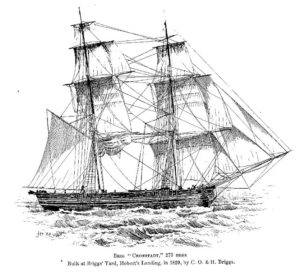December 19, 1919
By: Henry T. Claus
Transcribed and edited by Jane Estabrooks
Rapid Accretion
 Another interesting shipbuilder of his time was Alden Briggs of the Briggs family which played so important a part in Plymouth County history. Alden Briggs had the peculiar habit of adding, from year to year, by compound interest to the value of his possessions, so that each year instead of allowing for depreciation he valued his properties higher and higher. At one time, for instance, he valued his watch at $2,000 and his anvil at $1,500.
Another interesting shipbuilder of his time was Alden Briggs of the Briggs family which played so important a part in Plymouth County history. Alden Briggs had the peculiar habit of adding, from year to year, by compound interest to the value of his possessions, so that each year instead of allowing for depreciation he valued his properties higher and higher. At one time, for instance, he valued his watch at $2,000 and his anvil at $1,500.
Alden Briggs did not build many vessels on North River because he spent so much of his time helping his brothers in Milton and Salem. He was considered one of the best iron workers of his day and when Enos Briggs in Salem was called upon to build the frigate Essex in 1798 the first thing he did was to summon his brother. Another thing that Enos Briggs did was to insert the following notice in a Boston newspaper:
“The Salem Frigate. Take notice, Ye Sons of Freedom! All true lovers of the liberty of your country step forth and give your assistance to building the frigate to oppose French insolency and piracy. Let every man in possession of a white oak tree be ambitious to be foremost in hurrying down the timber to Salem and fill the compliment wanting, where the noble structure is to be fabricated, to maintain your rights upon the seas and make the name of America respected among the nations of the world. Your largest and longest trees are wanted, and the arms of them for knees and rising timber. Four trees are wanted for the keep which altogether will measure 146 feet in length and hew sixteen inches square. Please to call on the subscriber who wants to make contracts for large or small quantities as may suit best and will pay ready cash.”
First American Ship Around the World
But when all is said and done, North River’s story is not so much one of men, as it is of things. Just as posterity will be inclined to mark the epochs of the Great Way by its decisive battles, so the present thinks of the river in terms of this ship and that. Around each of the 1,000 vessels is woven a story, often of little moment of itself, but taken in conjunction with the 999 others. Illuminative of the whole eventful history of Plymouth County and our South Shore.
There were, for example, the old Columbia of 220 tons built by James Briggs at Hobart’s Landing in 1773 and one of the hundred or more famous vessels to bear this illustrious name. The Columbia was the first American ship to circumnavigate the globe and also the ship which explored the Columbia River in Oregon, to which “stream” it gave its name. It was on Sept. 30, 1787, that the Columbia, in company with the Washington, and in prosecution of a plan of some Boston merchants to combine the trade of the Atlantic Coast, the fur trade of the Pacific Northwest and the China trade, set out on her long trip. She was laden with blankets, knives, iron bars and other articles which could be exchanged for the furs of the Northwest Indians and the furs in turn were to be exchanged for the things which Boston wanted and the Orient had to offer. The perils met and overcome on this trip need not here be considered; suffice it to say that the two ships proceeded to the Cape de Verde Islands and thence to the Falkland Islands. In January 1788, they doubled Cape Horn, soon after which time they were parted during a violent storm and went on their separate ways. With the trails of the Washington we are not concerned. The Columbia, however, after being seriously damaged by the elements, arrived in Nootka Sound in October and spent the winter and the following summer there. In the fall of 1789 she started for China, touched at the Hawaiian Islands for provisions and refreshment and on December 6 reached Canton, where Captain Kendrick exchanged his furs for a cargo of tea valued at $60,000.
No Money In It
The homeward journey via the Cape of Good Hope was soon begun and on Aug. 10, 1790, the ship was back again in Boston in possession of the honor of having been the first vessel to carry the American flag around the world. But if the trip was epochal from the historical standpoint, it made no great appeal to the hardheaded merchants who had arranged it. The cargo brought back was not sufficient to pay the expenses of the voyage and for the time being, at least, the plan to link the wharves of Boston with those of the Orient was abandoned. But the Columbia soon left on another trip, this time to the Northwest coast, where the daring Captain Kendrick continued his pioneering work by exploring the Columbia River.
To Be Continued …
